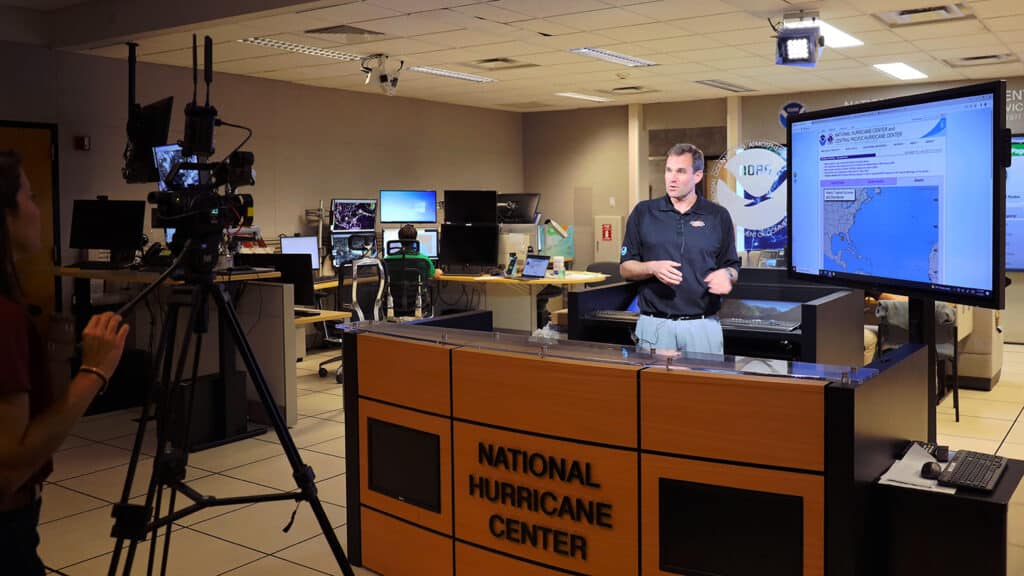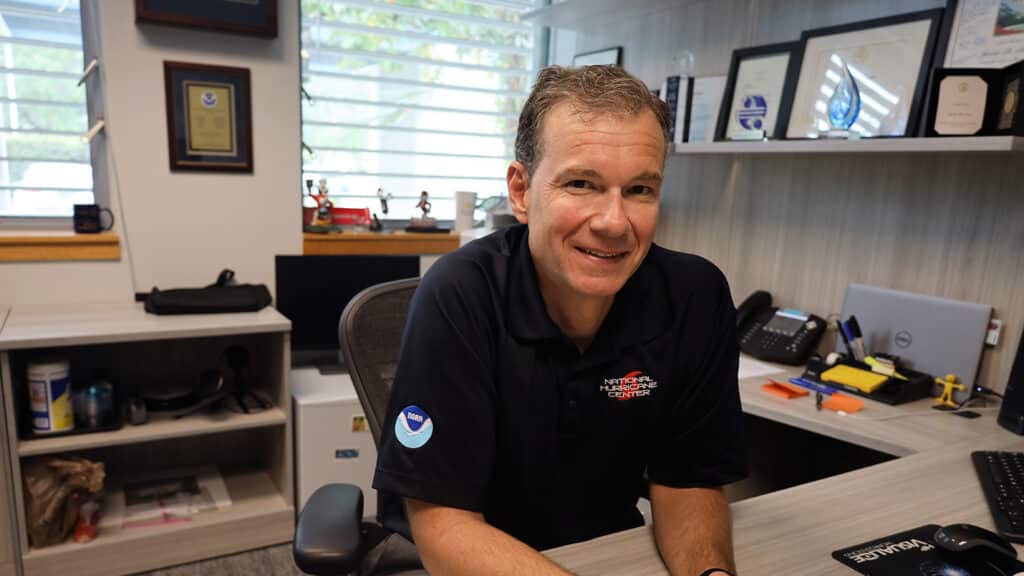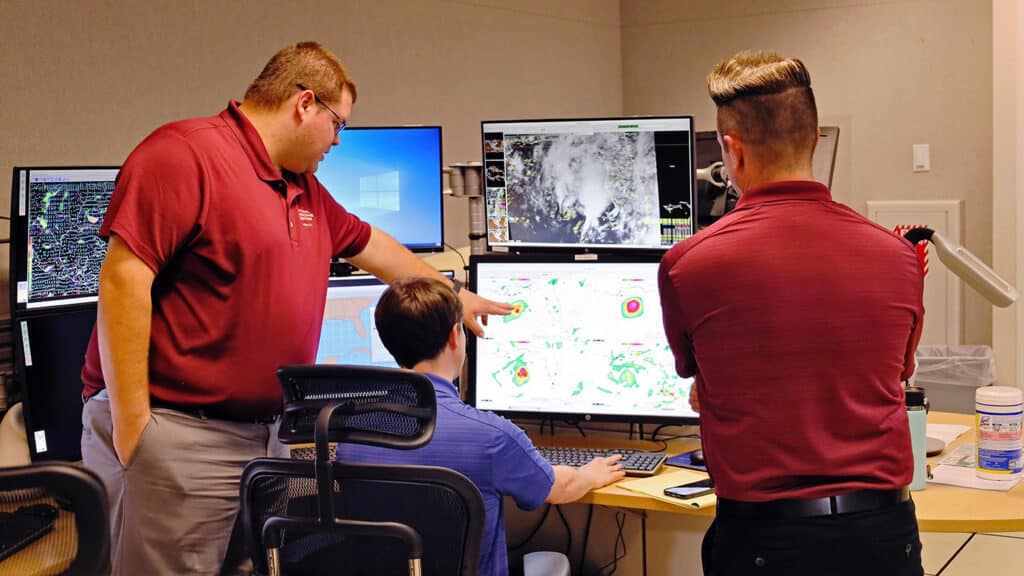Having an NC State degree would seem to make you a shoo-in for a high-level job in hurricane forecasting, if the current leadership of the National Hurricane Center in Miami is any indication.
The center’s director and deputy director have five NC State College of Sciences degrees between them, giving them a breadth of knowledge about the causes of nature’s most devastating storms that spans nearly half a century.
Yet Michael Brennan and Jamie Rhome say they spend as much time studying the behavioral sciences of communication, planning and public policy as they do poring over the hard sciences of meteorology and climatology they know so well.
Back when weather science was less precise, media sources were simpler and more centralized, which made it easier to disseminate weather-related information. Today, forecasting science has improved, but in the age of social media, communication has become fractured and complex.

“We have so much more information now to give people,” Brennan says, “but the information landscape is splintered into a million pieces.”
That’s why Brennan has spent a significant amount of time doing public relations and outreach events since he was named NHC director in April of this year. He’s gone up and down the Gulf and Atlantic coasts on informational tours with other agencies and organizations to emphasize the importance of preparing for approaching storms.
He even threw out the first pitch at a Miami Marlins baseball game, as part of his effort to find different ways to deliver his message to the people who need to hear it most.
“We have a pretty big megaphone,” Brennan says. “We still have to go on television, but there is also livestreaming, Facebook, Twitter, all kinds of communication platforms. We have to push everything into all the new spaces that are created, because generationally there’s huge differences in where 20-year-olds get their information from how their parents or their grandparents get it.”
“It is science that impacts lives, which goes right to the core of the university’s mission: to better the lives of the people of North Carolina and the nation.”
The day before the start of the 2023 hurricane season, Brennan took time out from the NHC’s annual media update to brief the White House and President Joe Biden about what to expect from this year’s Atlantic hurricane season.
The official prediction is a near-normal season, which sounds relatively benign but is definitely not, Brennan says.
“We are expecting a near-normal level of activity, which is not great news,” he says. “That means 12 to 17 named storms of at least tropical storm strength, five to nine that develop into hurricanes and one to four of them becoming major hurricanes.”
That prediction is in line with the 2023 forecast made by Lian Xie, NC State professor of marine, earth and atmospheric sciences.
These forecasts are intended to help coastal and inland populations know and evaluate their risks during hurricane season, which began on June 1 and continues through November, with increased chances of a hurricane making landfall beginning in August.
A Wolfpack Flavor
Brennan, the NHC’s 14th director, is a three-time NC State graduate, with a bachelor’s degree in meteorology (1999) and a master’s (2001) and doctorate (2005) in atmospheric science. A native of Roanoke, Virginia, Brennan came to NC State to learn about meteorology, a fascination that began when he was 8 after a post-tropical storm flooded his hometown and destroyed his grandmother’s home.
Deputy director Jamie Rhome, who served as the interim NHC director for one year before Brennan’s appointment, has both a bachelor of science (1999) and a master’s in meteorology (2003) from NC State. He oversees the center’s storm surge program and participates in its robust outreach programs.

Among the 35 or so full-time NHC staff, nearly one-third have NC State undergraduate, master’s or Ph.D. degrees.
Their presence gives the center, located on the campus of Florida International University, a distinct Wolfpack flavor.
“Our work here gets to the heart of why I went to NC State to begin with,” Brennan said. “It is not just science for science’s sake. It is science that impacts lives, which goes right to the core of the university’s mission: to better the lives of the people of North Carolina and the nation.”
“What I learned at NC State really resonates at the Hurricane Center.”
Rhome, a native of Roanoke Rapids, says his time at NC State taught him a practicality that is necessary every day he goes to work.
“What we do here is apply science to real-world challenges,” he says. “We don’t have a lot of time to contemplate life or pursue perfection. When a hurricane is coming, you have to get a forecast out, and you have to get it out on time.
“What I learned at NC State really resonates at the Hurricane Center.”
A North Carolina Challenge with Global Implications
It’s not surprising that North Carolina has its fingerprints all over the NHC.
Since 1851, the state has been hit by 60 of the 308 hurricanes that have made landfall on the East Coast. That’s about half as many as top-ranked Florida, but not far behind the larger Gulf Coast states of Texas (66) and Louisiana (64).
The state’s barrier islands along the Outer Banks bear the brunt of those storms, as do the agricultural communities east of Interstate 95. In addition, Raleigh and other inland municipalities have sustained major damage from storms such as Hugo (1989), Fran (1996), Floyd (1999), Matthew (2016) and Florence (2018).
Brennan definitely keeps an eye on North Carolina and his home state of Virginia when tropical depressions begin forming in the southeastern Atlantic Ocean, knowing that storms are getting stronger and there’s more property to be damaged up and down the coast.
“There is just more stuff there than there used to be,” Brennan says. “More people are moving to coastal areas, with more infrastructure, bigger homes, more valuable homes. The amount of damage a storm can do in certain places compared to 50 or 100 years ago is going to be much, much greater.
“In a changing climate, there are a couple of things we can be more confident of, especially regarding water. Storm surges are going to get worse because sea levels are rising. We are now observing places that we think by the end of the century will have surges two to three feet higher.”
As a result, there will be more flooding everywhere, which puts both property and people in greater danger.
That’s why the NHC does so much social science work: they’re trying to get people to change the behaviors that put them at risk in a storm.
“Ninety percent of all tropical storm and hurricane fatalities are due to water in some form,” Brennan says. “It could be freshwater flooding, storm surge or rip tides, which can happen from a storm as far as 500 miles away.”
Accordingly, the center’s messages are more firm these days, and the wording has gotten significantly stronger.
“We have used words like ‘catastrophic’ and ‘unsurvivable,’” he says. “Those words are carefully chosen to emphasize the danger of an approaching storm.”
But what if the forecast is wrong? That, of course, is a forecaster’s worst nightmare — telling people they’re in harm’s way and then having the storm pass without an impact.
“No forecast is ever going to be perfect, and that’s a challenge,” Brennan says. “We are never going to be able to tell you four days in advance exactly where a storm is going to land or that there is going to be a storm surge of 15 to 20 feet.
“At the same time, we can’t allow complacency to settle in. The communication has gotten harder in some ways, but that’s something we are constantly working on.”

In the end, the NHC’s mission to safeguard people and their property aligns perfectly with the passion Brennan and Rhome brought with them from NC State.
“What better mission could you have than to save lives and property?” Brennan says. “It’s the core of the National Weather Service and all of its divisions. We have an important piece of it here for predicting hurricanes, which are such large-scale, potentially catastrophic events.
“Who wouldn’t feel passionate about that?”
This post was originally published in NC State News.
- Categories:



